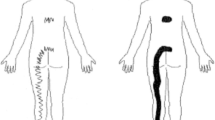Summary
Pain drawings were obtained from three groups of patients: 51 with lumbar disc herniation; 55 with lumbar stenosis, and 42 with benign low back pain. On grid assessment, patients with disc herniation and stenosis who complained of radiating pain or intermittent claudication had a significantly larger number of grids for the extremities than those with benign low back pain. In studies of the relation between the characteristics of the pain drawing and the outcome of treatment, most patients with 19 grids or less, or a score of 3 points or less, had a satisfactory outcome. Those with more grids or a higher score tended to be unsatisfactory. Pain drawing permits differentiation of the three patterns of pain and is useful for predicting the outcome of treatment.
Résumé
Des schémas de douleurs ont été obtenus à partir de 3 groupes de patients: 51 avec hernie discale lombaire (H); 55 avec sténose du canal lombaire (S); et 42 avec lombago bénin (L). Une méthode d'estimation par quadrillage (Capra et al., 1985) et l'echelle de Ransford (1978) ont été utilisées pour l'évaluation des schémas de douleurs. Concernant l'estimation par quadrillage, les patients avec H et S, souffrant de douleurs radiantes ou d'une claudication intermittente, présentent un nombre significativement plus important de quadrillages pour les extrémites que pour ceux du groupe L. Dans les études concernant la corrélation entre les paramètres des schémas de douleurs et les conséquences du traitement, la plupart des patients qui avaient 19 quadrillages ou moins selon l'estimation par quadrillage ou note de 3 ou moins à l'echelle de Ransford semblent avoir obtenus des résultats de traitement définitivement satisfaisants, alors que les patients avec 19 quadrillages ou plus, ou 4 notes ou davantage, présentent des résultats de traitement peu satisfaisants. Ces découvertes indiquent qu'un schéma des douleurs permet la différentiation des exemples de douleurs H, S et L et qu'il est utile pour la prédiction des conséquences d'un traitement de patients souffrant de douleurs au bas du dos.
Similar content being viewed by others
References
Capra P, Mayer YG, Gatchel R (1985) Adding psychological scales to your back pain assessment. J Muculoskel Med 2: 41–52
Dzioba RB, Doxey NC (1984) A prospective investigation into the orthopaedic and psychologic predictors of outcome of first lumbar surgery following industrial injury. Spine 9: 614–623
Goldman S, Merritt JL (1991) Using the pain drawing in evaluating low back disorder. J Musculoskel Med 8: 14–24
Hildebrandt J, Franz CE, Choloba-Mehnen B, Temme M (1988) The use of pain drawings in screening for psychological involvement in complaints of low-back pain. Spine 13: 681–685
Inoue S, Kataoka O, Tajima T (1986) Assessment of treatment for low back pain. J Jpn Orthop Ass 60: 391–394
Mann III NH, Brown MD, Hertz DB, Enger I, Tompkins J (1993) Initial-impression diagnosis using low-back pain patient pain drawing. Spine 18: 41–53
Mooney V, Cairns D, Robertson J (1976) A system for evaluating and treating chronic back disability. West J Med 124: 370–376
Ransford AO, Cairns D, Mooney V (1976) The pain drawing as an aid to the psychologic evaluation of patients with low-back pain. Spine 1: 127–134
Sanderson PL, Wood PLR (1993) Surgery for lumbar spinal stenosis in old peaple. J Bone Joint Surg [Br] 75: 393–397
Southwick SM (1983) Current concept review. The use of psychological tests in the evaluation of low-back pain. J Bone Joint Surg [Am] 65: 560–565
Udèn A, Aström M, Bergenudo H (1988) Pain drawings in chronic back pain. Spine 13: 389–392
Author information
Authors and Affiliations
Rights and permissions
About this article
Cite this article
Takata, K., Hirotani, H. Pain drawing in the evaluation of low back pain. International Orthopaedics 19, 361–366 (1995). https://doi.org/10.1007/BF00178350
Accepted:
Issue Date:
DOI: https://doi.org/10.1007/BF00178350




